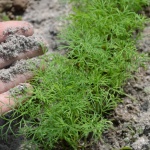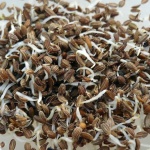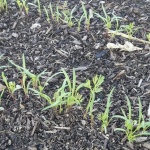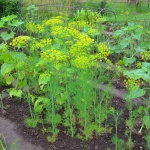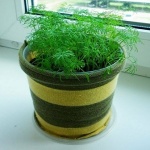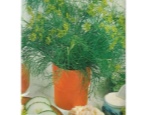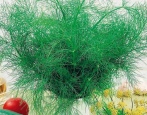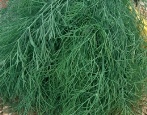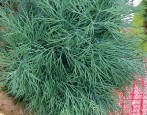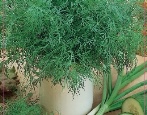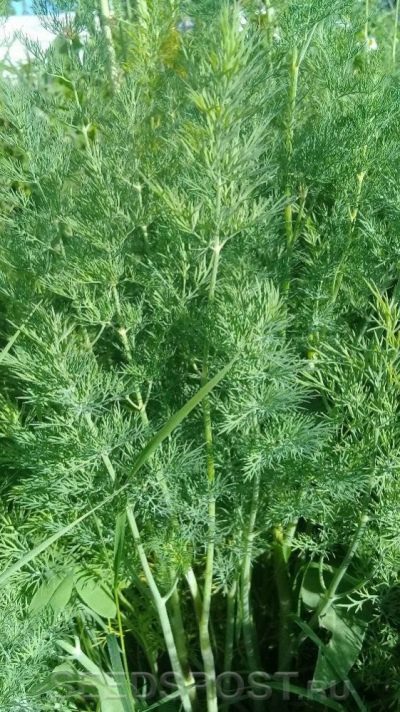
- Authors: Kandoba E.E., Kandoba A.V.
- Year of approval: 2015
- Ripening terms: mid-season
- Foliage: strong
- Leaf size: long
- Leaf color: green
- Dissection of leaves: strong
- Leaf segments: long and wide, flattened filamentary
- Plant height in the flowering phase, cm: 90-100
- Umbrella size: large
A mid-season variety of bunched dill Vladyka is suitable for any soil. This rather compact bush unexpectedly produces the highest yields of greens among other known varieties, surpassing many competitors in this indicator. It is also very beautiful, and its dark green leaves give off a bright spicy aroma.
Breeding history
The high-yielding variety of dill Vladyka was recently brought out by domestic breeders Kandoba EE and Kandoba AV from the Premium Seeds agricultural firm. In 2015, the culture was entered into the State Register and approved for use in personal subsidiary plots in most Russian regions.
Description of the variety
The gardeners appreciated the short Vladyka for his compactness, as well as high, even incredible for such a plant, productivity. Tufted dill can be sown several times per season, which is how such productivity is achieved.
Characteristics of the appearance of the plant
The considered dill variety is a compact, low plant with long stem formation. During flowering, the height of the stem, which has an average diameter, reaches 90–100 cm. The stem is colored in dark green tones with a blue tint, an intense waxy bloom is observed.
The dill leaf is green, long, diamond-shaped, heavily split and has a waxy coating. Segments of leaves are flattened, filiform, long, wide. The large and convex central umbrella has an average number of rays. Weight of each plant during harvest:
- for greens - 30–35 g;
- on spices - 130-140 g.
A feature of the plant is the fact that the Lord does not have a stem for a long time, therefore it grows in the form of a very dense and compact, not very tall bush, in which 4–6 lower internodes are close together. During the season, lateral shoots grow in the leaf axils, which is not typical for other varieties.
Purpose and taste
Dill Vladyka has a rather strong and bright aroma. The product will remain fresh for a long time after cutting. Dill can be used in different ways: fresh, for pickling, pickling, drying. If the greens of Vladyka dill are frozen at a temperature of -18 °, it will retain all the qualities of a fresh product: it will remain the same fragrant, completely retain all vitamins, emerald color, excellent taste.
Ripening terms
Experts classify the Vladyka variety as mid-season. The period of time between shoots and the appearance of umbrellas in a culture is long: 65–70 days. Harvesting can be scheduled for July-August.
Yield
The results of numerous studies show that today it is the most productive dill, which stands out for this indicator among many known varieties. This can be achieved by cutting multiple times, and this is at least 4-5 times per season. Average yield indicators:
- for greens - 2.3-3.0 kg / sq. m;
- for spices - 4.0-4.5 kg / sq. m.
Growing regions
Dill Vladyka is a frequent visitor to the beds of various farms practically throughout the country. These are the Central Black Earth Region, as well as the Northern and North-Western, Central and Volga-Vyatka regions. The culture is grown in the North Caucasus, the Middle and Lower Volga, the Urals, Siberia and the Far East.
Growing and care
The Vladyka variety of bunched dill is unpretentious to soil conditions, but he needs a sufficient amount of light. Sowing dates are usually standard: April 25 - May 15. It is better to plant a plant on a garden bed according to the scheme 35X20 cm, the depth of immersion of the seed is 2-3 cm. Seedlings should appear on the 10-15th day. A crop for good development requires regular watering, as well as loosening of row spacings, mandatory feeding with complex mineral fertilization.
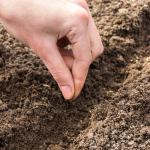
Dill cultivation is available in any conditions: open and closed ground, on a balcony or windowsill. Before planting dill, you need to carry out pre-sowing seed treatment, correctly determine the timing, prepare the beds.
